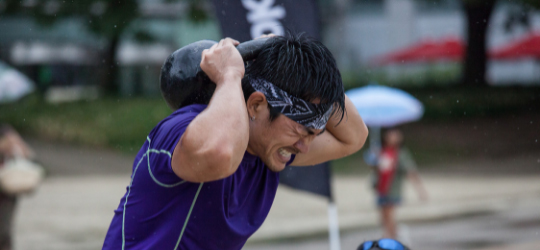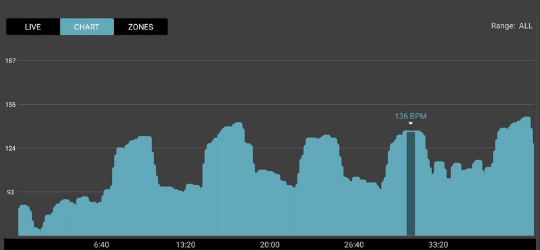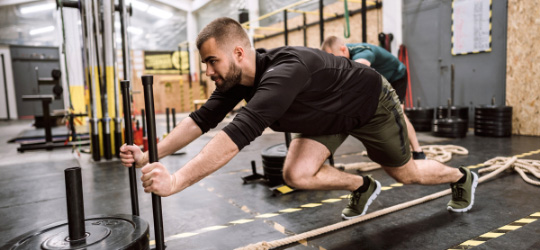Walk into almost any gym at any time, and you’ll inevitably find someone on a treadmill, elliptical, or stationary bike putting in the minutes or miles at a constant, steady pace.
The world of state state training at low to moderate intensities has been a part of training programs and fitness for generations. For groups like endurance athletes, the military, combat athletes, and more, it’s traditionally been the single biggest part of their training.
And yet in the last decade or so, there has been a shift away from the “low and slow” approach to fitness and conditioning towards the HIT model. Miles on the pavement have been replaced by 20 second sprints for only a few minutes of total work.

Proponents of higher intensity training point to research like the infamous Tabata study to support the idea that if you go hard enough, you only need minutes of hard work instead of hours.
But is this true?
Is high intensity interval training that much more effective than lower intensity steady state work? Is there any reason to do lower intensity work at all?
The answer is that all things being equal, higher intensities absolutely put the body under more stress than lower intensities. This higher level of stress then causes a greater reaction by the body.
So yes, in the short run, more stress does equal faster results.
In the long run, however, nothing is for free. There is also a cost to the higher level of stress that comes with higher intensities.
Both research and the real world show that the faster you get results, the faster you’ll also be likely to hit plateaus.
Even the Tabata paper showed that the high intensity group didn’t see any real improvements in their VO2 max throughout the entire second half of the 6-week study.
The lower intensity group, on the other hand, saw steady and consistent improvements throughout.
And as we’ve already covered, any time you have more stress than you can recover from, bad things happen.

The truth about the high vs. low intensity debat is that there shouldn’t be a debate at all. It’s not a question about which one is more effective.
They both play an important role no matter what your training goal may be.
The only real question is about how you incorporate them both into your training plan. That’s where the Morpheus blue zone can help you
Training in the blue zone
The Morpheus blue zone is where you’ll spend the majority of time when you’re doing steady state work. This type of training can also be called cardiac output since one of the main goals is increasing how much blood and oxygen your heart can pump throughout your body.
There are several areas that higher volume, lower intensity training in the blue zone can help you with:
- Build your overall aerobic fitness
- Increase your average HRV and
- Lower your resting HR
- Promote faster recovery between workouts
- Create a foundation to support higher intensities
- Help develop more efficient movement patterns
There are two general ranges within the blue zone you’ll want to use when doing this type of lower intensity work.
- SS1 – Middle of the blue zone
- SS2 – Top of the blue zone
The middle of the blue zone is where you’ll want to do most of your steady state work if you’re starting with a lower level of fitness and/or your recovery for the day is on the lower end.

A good guideline is that if your average HRV is below 70, or your recovery score is below 80% for a given day, the middle of the zone is a good target.
This should generally be at what’s called a conversational pace, meaning you could carry on a conversation while you’re training at this level.
If you have a higher level of fitness, average HRV above 70, then you can up the intensity of steady state work a bit by training more towards the top of the blue zone.
Blue zone exercises
One of the things people complain the most about when it comes to steady state work is that it’s boring. Doing the same thing over and over and over again can definitely be that, but there’s no reason that this is how you have to do your lower intensity work.
First of all, even though it’s referred to as steady state does not mean you have to go at the exact same speed the entire time you’re doing it.
You can alternate between the middle of the blue zone, up to the top, and back down, for example. The most important thing is simply getting in enough time at the lower intensity heart rates.
You do not have to make it boring by staying at the exact same pace from start to finish.
The second thing is that you also don’t have to do the same exercise the whole time either. There’s a wide variety of exercises you can do in the blue zone:
- Running
- Jumping rope
- Swimming
- Bicycling
- Sled dragging
- Elliptical
- Rower
- Medicine ball circuits
- Bodyweight calisthenics
There are even benefits to doing different exercises in a circuit, alternating every minute or two, if you like. The benefits come from just spending time at lower intensities, exactly what exercises you do, or how you do them, is less important.

So if you find jumping on a treadmill or bike for 20-30 minutes boring, then don’t do that. Give yourself a circuit of 4-5 different exercises, spend 1-2 minutes on each, and rotate through until you’re done.
How much time should you do steady state training?
On the lower end, even 15-20 minutes of this type of work can promote recovery.
For general aerobic fitness and conditioning, anywhere from 30-60 minutes or more in a workout can be necessary, depending on where your fitness level is now and where you want it to be.
If you’re on the lower end of the fitness spectrum, 2-3 days per week of 30 minutes can make a huge difference. As your fitness increases, you’ll need to start doing more of it to continue to see progress.
In the big picture of fitness, you should think of lower intensity, steady state work in the blue zone as the counterbalance to the higher intensity work you do in the green and red zones.
Together, training in each of the three zones using different methods will help you build your fitness step-by-step and keep you moving towards your goals without getting stuck at plateaus or being plagued by nagging injuries.
Action step
Starting in your lower blue zone and training until you hit the top of the blue zone is a great way to learn what low-intensity training should feel like. And it’s also an easy way to warm-up before your workout.
Try it out during your next training session.
